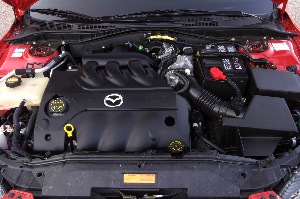Mazda has long enjoyed a reputation as a performance car company with the RX8 and MX5, as well as has been able to consistently hit the target when it comes to affordable sport sedans that are as
reliable as they are fun to drive. 
This month, we’ll be taking a look at the popular Mazda6 and Mazda3. We’ll cover some of the common underhood repairs that will find their way to your shop, while looking at some of the new technology that has been incorporated and getting more common in our bays. Illuminated check engine lights are becoming the most common customer complaint that we are seeing in general, and Mazdas seem to be following that trend.
I know we would rather be diagnosing a driveability issue along with the code. If it’s not running well or stalling, and you can duplicate it, you will know when it’s fixed. And, we all like the satisfaction that brings, not to mention the increased confidence in the final repair. The other side of the coin brings the challenges faced when looking for a problem that’s not apparent — one that requires you to have a solid understanding of the system and how it works. This includes knowing what it takes for the code to be set.
DRIVEABILITY ISSUES
Let’s start with cars that have driveability problems. One thing that hasn’t changed in all the years I’ve been doing this are the basic complaints we hear. It’s either running rough at idle, missing or “skipping” under load, hesitating (at speed or throttle tip in) or there’s no power. It’s up to the service writer to ask the right questions when the appointment is made so the tech has the information needed to make a successful diagnosis and repair.
In the old days, that would be all the tech would have to work with and hoped the problem would be evident. But things are different now with on-board diagnostics. If any of the driveability problems described are caused by a fault in a monitored system, a code should be stored.
One of the most common failures we see on both early- and late-model Mazdas is a torn air intake hose between the airflow sensor and the throttle body. The symptoms that result from this failure are hard to miss. The usual complaint is a big stumble or stall on initial acceleration, but it may or may not set a system lean code. As the engine torques on the mounts, the crack in the hose will open, allowing unmetered air into the manifold while, at the same time, reducing airflow through the sensor. Of course, when the engine stumbles, the crack closes, allowing the engine to accelerate, starting the entire process all over. Many times, the customer will mistakenly think the transmission is the problem.
Although it’s simple to diagnose with a visual inspection, I’ve seen some good technicians tricked by this one. Be sure to inspect the hose closely for cracks that won’t be obvious but will become evident when the engine is loaded against the mounts.
A vacuum hose can be the cause of another problem that may have you shaking your head. On the popular Mazda3, you may have a customer complaining about a siren-like or screeching noise coming from under the hood. The more attentive ones may mention that it changes with throttle position.
While your first thoughts will have you looking at the drive belts, the real culprit is a failed PCV hose located under the intake manifold. The hose will weaken and split, allowing air to be drawn through the hose and causing the noise. While the hose can be accessed with starter removal, some techs feel removing the intake manifold is an easier way to go. So, while the repair sounds simple, be careful when writing the estimate.
While we’re talking about the Mazda3, there have been some reports of an erratic stalling problem that may or may not set a crank sensor code, but the sensor will check out fine. If the car has aftermarket drive belts installed with an alternate cut, suspect a buildup of static electricity that finds its way to the sensor. You may see sparks jumping to the sensor when the car is idling, but if you’re faced with an intermittent stall, keep it in mind.








